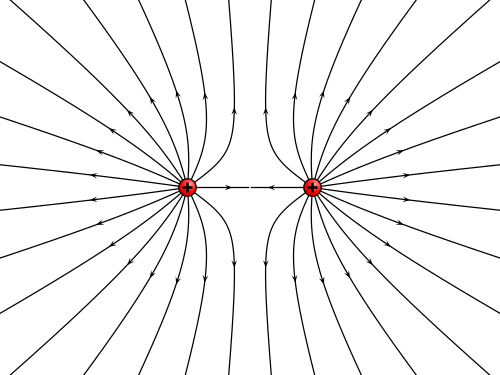I spent the time thinking about it because I want a good image of the field that is a.) useful for my students and b.) available for me to use without bending any copyright laws. I've been mostly generating my own artwork for classes (with the side goal of creating a CreativeCommons licensed library for people to make use of) but creating an electric field diagram isn't something that can easily be whipped up in a drawing program.
After quite a bit of searching for images labeled for reuse, I happened to find a python program that can be used to create vector field plots of various electromagnetic configurations. Awesome, right? I even found an example code of the field that is generated by one positive and one negative charge.
What I wanted was the field around a set of like charges, but I can read source code and figure out how to change a negative sign, right? Wrong. I need to spare myself the embarrassment of posting my attempts to correctly plot the field, but know that it went from bad to worse.
Not willing to give up, I went back to wikimedia and found every uploaded image which had been made using this program. Fortunately, this included the charge configuration I was looking for:
Unfortunately, I wasn't too thrilled with the horizontally oriented field line right in between the two charges. The electric field is zero at a point equidistant from the two (identical) charges. And while, the arrows are pointing in opposite directions along this line, I'm not sure if it is obvious to my students that the electric field at that point is zero.
(Side note: I'm starting to see why Randy Knight uses vector field plots, instead of electric field lines. We're not using the Knight textbook, and these drawings are my attempt to bridge the gap between the two representations and hopefully make things more understandable.)
What I'm going to do, unless I come up with something I like better, is use this image instead:
(Side note: I'm starting to see why Randy Knight uses vector field plots, instead of electric field lines. We're not using the Knight textbook, and these drawings are my attempt to bridge the gap between the two representations and hopefully make things more understandable.)
What I'm going to do, unless I come up with something I like better, is use this image instead:
Gone is the electric field line in the middle and added are more vectors. It's not perfect, but I'm not sure I can spend more time finding the perfect representation anymore.


